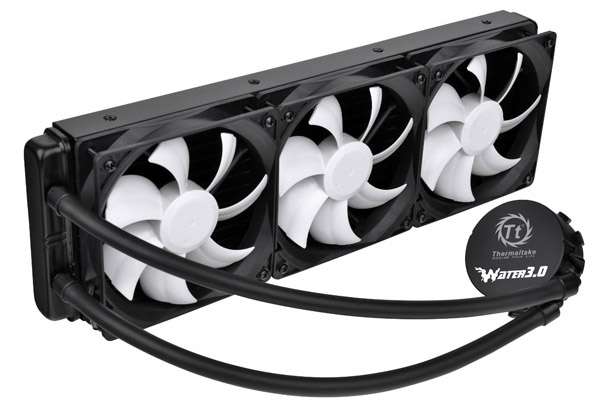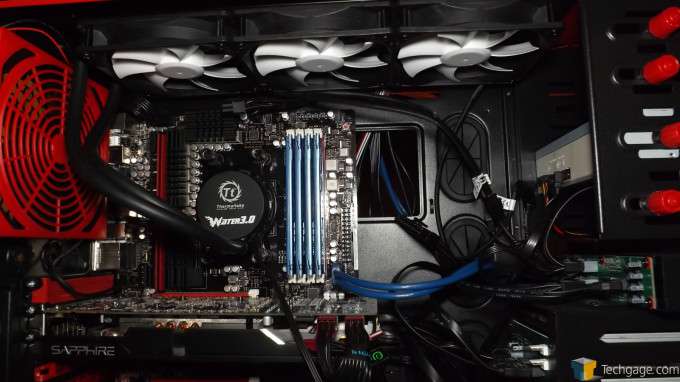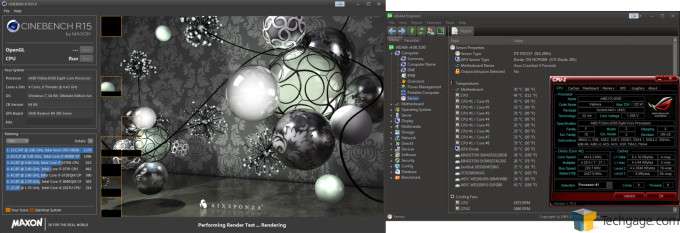- Qualcomm Launches Snapdragon 4 Gen 2 Mobile Platform
- AMD Launches Ryzen PRO 7000 Series Mobile & Desktop Platform
- Intel Launches Sleek Single-Slot Arc Pro A60 Workstation Graphics Card
- NVIDIA Announces Latest Ada Lovelace Additions: GeForce RTX 4060 Ti & RTX 4060
- Maxon Redshift With AMD Radeon GPU Rendering Support Now Available
Thermaltake Water 3.0 Ultimate Review – Keepin’ It Cool

Thermaltake is taking us from Extreme to Ultimate with its new Water 3.0 closed-loop CPU water cooling solution. This brings us up to three 120mm fans, a doubling of the cooling surface, and a more powerful pump. This makes it the biggest and strongest Water offering yet. Will this effort bring prefab water cooling to new heights?
Page 2 – Installation, Testing & Final Thoughts
The installation instructions are illustrated simply enough but they can be a little challenging to understand, especially when there are only pictures and no written instructions. To make things easier, I performed a dry-run before any screws got tightened, this ensured that installation was easy, effortless, and was not too time-consuming. If you have any questions about how to perform a certain step, Thermaltake has a video on how to install the Ultimate for an Intel CPU.
During the course of the installation, I never encountered anything that felt cheap or brittle. The only problem that I had was the length of the coolant lines, which forced me to install the Ultimate in one direction. While this wasn’t a major problem, I did run into an issue of the radiator touching the rear case fan, thus preventing optimum installation. Thankfully, I was able to circumvent this minor inconvenience by moving the radiator forward a little, albeit with fewer screws, with no further issue.
Without further ado, here are the specs of the PC we will be testing:
| AMD AM3+ Test System | |
| Processors | AMD FX-8350 Black Edition Vishera 8-Core 4.0GHz |
| Motherboard | ASUS Crosshair V Formula (1703 BIOS) |
| Memory | Kingston HyperX 4x4GB – DDR3-1333 9-9-9-24 |
| Graphics | Sapphire AMD R9 280 (AMD Catalyst 14.4 Driver) |
| Audio | Onboard |
| Storage | Kingston SSDNow 128GB SSD |
| Power Supply | Thermaltake Toughpower 1200W Gold |
| Chassis | Azza Fusion 4000 Full-Tower |
| Cooling | Thermaltake Water 3.0 ULTIMATE Liquid Cooler AMD Stock Cooler |
| OS | Windows 7 Professional 64-bit |
During the course of these tests, the room was a comfortable 72ºF or 22ºC. All temperature numbers are from the socket temp, not the core. The reason for this is that the manufacturer specifies the physical temps for the CPU’s thermal limits and the motherboard is set up to read that information, not the core temp. Core temp has a tendency to provide numbers that might be unrealistic and inconsistent (core temp was listed as 8ºC); which is why I choose to omit them. All temperature measurements were taken with AIDA64 Engineer.
Testing
The AMD Stock CPU Cooler and the Water 3.0 Ultimate were both given 10 minutes to reach their peak idle temps. To push the CPU to its limit I used Cinebench R15. With its separate CPU and GPU test, it gave me the opportunity to only test what I needed. I also performed the test 5 times. This way I was pushing the CPU to its temperature peak to get the most accurate numbers.
Throughout the testing process, the Ultimate never became unreasonably loud. The majority of the time, the case fans seemed to be more audible than the Ultimate’s fans did.
I was able to push my stable overclocking limit to 4.4GHz, with both the AMD CPU Cooler and the Water 3.0 Ultimate. Anything beyond that, even with the Ultimate, the CPU just wouldn’t remain stable at idle. This means the CPU was at its limit, not the Ultimate’s ability to keep it cool.
| Stock Cooler | Water 3.0 Ultimate | |
| Idle | 47ºC | 33ºC |
| Load | 64ºC | 43ºC |
| OC Idle | 52ºC | 35ºC |
| OC Load | 68ºC | 44ºC |
It is common to see stark differences between air cooled and any water cooling system. What is uncommon is the temperature variance seen between the idle and load numbers with a prefab water cooling kit. These numbers perfectly illustrate why the Ultimate’s increased surface area is so important.
I mentioned before I could barely hear the Ultimate’s fans over the case ones. That trend was consistent while the CPU was overclocked as well. This left me in awe of the Ultimate’s performance, especially when you consider I could barely hear it and the CPU only increased by 1ºC at a full load while overclocked.
Final Thoughts
As I mentioned before, there wasn’t a whole lot that I could find at fault with the Water 3.0 Ultimate, which is currently etailing for $139.99. This may seem like a premium price, but it is in fact somewhat reasonable. Just to water cool a CPU with a home-made triple-rad solution, you would be looking at around $200 when you consider all the parts I mentioned earlier, and that is a modest number to boot.

The way I see it, the Water 3.0 Ultimate changes the fundamental nature of how we all should see prefab water cooling kits. With the versatility to support a wide range of CPU sockets and its ability to provide impressively low temperatures with low noise, while overclocked, this is an easy recommendation.
This may be a one trick pony, but it does the trick very well, and it should be considered by custom water cooling proponents, veterans and newcomers alike.
Pros:
- Extremely efficient.
- Silent when pushing overclocking limits.
- No more custom software.
- Push/pull fan setup available.
Cons:
- Coolant lines too short.
- One trick pony.
Support our efforts! With ad revenue at an all-time low for written websites, we're relying more than ever on reader support to help us continue putting so much effort into this type of content. You can support us by becoming a Patron, or by using our Amazon shopping affiliate links listed through our articles. Thanks for your support!






